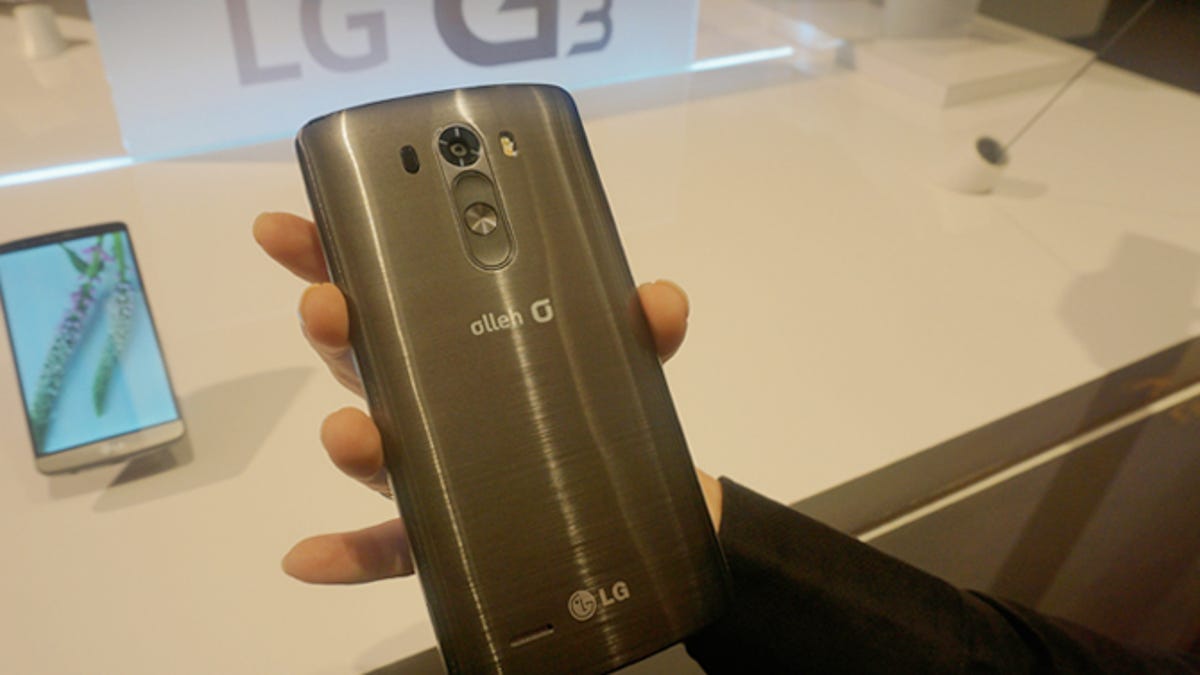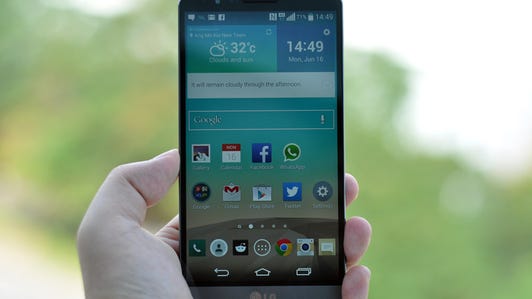
Nate Ralph/CNET
In the end, it was all about the lasers.
At least, it was to LG, which considered the laser-equipped camera — supposedly able to focus on images faster than the standard smartphone camera — to be one of the hallmark features of its G3 smartphone, the latest flagship product of the Korean consumer electronics conglomerate.
Its predecessor, the well-received if relatively modest-selling G2, proved that LG could stand with the big boys in the industry, namely Apple and Samsung and a design-minded HTC, with a different flagship phone. But with the G3, LG set out on a path to create a smartphone it could argue was superior to the competition, which meant injecting a little cool into the phone.
Related stories
- CNET’s LG G3 review
- Is the LG G3’s laser-equipped camera better than the Galaxy S5?
- How LG’s laser focus created the G3 super smartphone (Q&A)
- How LG’s G3 plans to break the iPhone-Galaxy S stranglehold
- How the LG G2 looked to “Gangnam Style” for inspiration
Enter the lasers.
“A laser sounds pretty sexy,” Ramchan Woo, head of LG’s mobile platform planning division, said in an interview with CNET. “A laser is one of the coolest items around the world.”
LG can use all the cool that it can get. Having long played second fiddle to Samsung as the other large Korean conglomerate, LG lacks any real significant brand identity. Like Samsung, LG can tap into its various component units to create solid products, but it doesn’t have the cult-like following of Apple or the marketing heft of its Korean rival. With a strong contender in the G3, the experimentally curvy G Flex, and the fan favorite Nexus 5, LG is starting to build a track record of noteworthy smartphones.
Even so, many remain skeptical that LG can break out as a coveted household name.
“A lot of the G3’s success will depend on how much LG is willing to invest in marketing — consumers are familiar with the LG brand, but do not seek out its phones,” said Avi Greengart, who covers consumer electronic products at Current Analysis.
LG ranked in the top five among global smartphone makers in the first quarter, although it ceded its No. 3 spot from a year ago to Chinese vendors Huawei and Lenovo, according to IDC. With a 4.3 percent share of the market, it lags far behind Samsung, which controls nearly a third of the market, and Apple, with 15.2 percent of the market.


Nate Ralph/CNET
Yet the company feels it has a legitimate shot to go after the competition with the G3. When it launched in Korea in June, the G3 reportedly outsold Samsung’s Galaxy S5 by a 3-to-1 margin during their respective launch weeks, according to Korean publication ET News. The G3 debuted in the US on Friday with AT&T, but will be available at all of the national carriers over the coming days.
Critically, the G3 has already won praise. CNET senior editor Aloysius Low called it the ” perfect flagship phone for early adopters, and suggested that the G3 could cause a major upset over the Galaxy S5.
Whether the G3’s laser-power camera is a genuinely useful feature or a gimmick remains a little unclear. CNET senior editor Andrew Hoyle conducted a test of the camera vs. the Galaxy S5, and only found it slightly faster and better in low-light conditions.
Still, in an industry where most of the improvements come in the form of better specs and bigger displays, the G3’s laser is at least different.
Last-minute laser
It was December, and Woo was starting to feel the pressure.
While most companies typically take a year in between flagship smartphones, LG was on an accelerated schedule. The predecessor G2 had just been released in September, and LG was looking to launch the follow-up a mere eight months later.
The planning had actually come together in 2012, and then LG worked with Qualcomm in May 2013 to optimize the new 801 Snapdragon quad-core processor for the phone. The design of the exterior and internal components of the G3 had been locked in.
Yet executives felt the G3 still lacked that cool factor — that difference maker that would help the smartphone stand apart from its competitors. The camera, in particular, lacked any real improvement.


LG
Woo found the answer in the unlikeliest of places: LG’s Hom-Bot robot vacuum division .
He happened to be at an R&D coffee break with engineers from the division when they started talking about a laser sensor the robot vacuum team had considered using to help gauge distance. The team ultimately decided to use other sensors. But Woo was intrigued, and had the robot vacuum engineers set up a meeting with the outside supplier of the laser.
After one demonstration, Woo was sold.
“There’s something about a laser,” he recalled. “It can be cool.”
But Woo faced a big problem. Adding a major element like a laser required a wholesale design of the G3’s mold and internal components — impossible under the company’s normal schedule. Woo had to pitch the laser sensor to Jong-Seok Park, CEO of the mobile division, and convince him to sign off on a last-minute change to the smartphone. Park was instrumental in changing the production process to allow for the laser addition.
Somehow, Woo said, the hardware team managed to redesign the smartphone mold and internal printed circuit board by January.
“I’m still not sure how they did it,” he said.
LG’s secret weapon
Woo felt that the laser-guided camera was the G3’s ace in the hole, so he opted not to alert the marketing team.
“The laser was so sensitive — it was so hot — that we kept it a secret,” he said, a reference to the excitement around it — and not the temperature.
When showing off prototype units in February and March, LG covered up the hole where the laser sensor would be, with executives saying only that it would be an infrared blaster. (“It is a sort of infrared blaster, so we weren’t lying,” Woo said.) The actual laser is located in the black pill-shaped spot to the left of the camera, opposite the flash.
On the development side, work was going virtually nonstop. LG had a dedicated facility set up in Qualcomm’s offices in San Diego, and the work would be handed off between LG in Korea and Qualcomm, so there was little downtime.


Nate Ralph/CNET
The two companies spent months tuning the camera and the photo algorithms, combining resources from both companies, according to Keith Kressin, vice president of product management for Qualcomm.
Qualcomm helped ensure that the G3 would work with the different carriers around the world and that its battery life would hold up with its much higher-resolution display. It also tweaked the camera so it would shoot photos faster and work better in low-light levels.
“That effort was monumental,” said Alex Katouzian, Qualcomm’s senior vice president of product management who helped work on the G3.
It wasn’t until April that LG let its marketing team in on the laser camera.
“They loved it,” Woo said.
Figuring out the cool
That LG would consider adding the laser illustrates the pressure that the smartphone vendors are under to separate themselves from the pack. But it wasn’t the only improvement.
After the G2 debuted in September, LG immediately began looking at the feedback. Critics called out the amount of unnecessary features and apps preloaded onto the phone, lamented the clumsy user interface, and blasted the lack of a removable battery or a microSD card slot.
In reaction, Woo set up a 30-30-30 goal: a 30 percent reduction in the binary code, preloaded apps, and options. The result is fewer bloatware, a cleaner and flatter user interface, and a binary system that takes up less than 2 gigabytes of space. The G3 also got a removable battery and the microSD card for expandable memory.


Now playing:
Watch this:
LG G3 loaded with laser, kill switch
2:52
The centerpiece feature was the G3 Quad-HD display, the first smartphone display that boasts four times the resolution of a standard high-definition screen and 65 percent more pixels per inch than the iPhone 5S’ Retina Display.
While the hardcore smartphone fanboys would appreciate the spec bump, LG knew the G3 needed more aesthetic appeal. LG had long wanted to employ metal, similar to Apple or HTC, shoring up a criticism that its plastic smartphone cases felt cheap.
The company had even found a way around the interference issues that have long dissuaded vendors from using metal, Woo said. There was, however, another problem: a metal smartphone with a 5.5-inch display would be “unacceptably” heavy.


Nate Ralph/CNET
“We started thinking of ways to make the phone look and feel like metal, but not actually metal,” Woo said.
LG tapped its internal Prestige Innovation Lab, which is tasked with creating higher-quality material for products as wide ranging as LG televisions and refrigerators, to create a new skin for the G3. The first samples weren’t very good. When Woo showed off the first mock-ups to its carrier partners last May, they employed an actual metal case. Woo assured his partners that the ultimate material would be lighter.
Another round of samples came in November, but the designers challenged the materials engineers to do better. Woo said he wasn’t happy with the material until April, just a month before the launch.
A marketing “double impact”
Ultimately, it may not matter how cool the G3 is if LG doesn’t bolster its marketing efforts. While LG’s brand resonates in Asia and with some mass-market customers, it continues to lag behind the likes of Samsung and Apple. It’s a dilemma facing other tech companies such as Sony and HTC.
LG G3 shows off high-res screen, metallic back (pictures)






“At this point, there’s a lot of brand inertia to overcome,” said Ross Rubin, an analyst at Reticule Research.
But commercials for the G3 are beginning to pop up in the US, and the carriers are working with LG on promotions. AT&T, for instance, is selling a bundle that includes the G3 with LG’s G Watch, one of the first smartwatches running on Google’s Android Wear software. Verizon Wireless will offer the G3 for $99, $100 cheaper than its competitors. T-Mobile has already been touting the preorder option for the smartphones. Chang Ma, senior vice president of LG’s US mobile computing division, said LG would benefit from the “double impact” of stronger marketing and more interest from consumers.
“Consumers are familiar with the LG brand, but do not seek out its phones.” -Avi Greengart, analyst, Current Analysis
“There’s going to be aggressive marketing support around G3,” Ma told CNET during the launch in May. He teased a significantly larger budget, without going into detail.
Woo is aware of the competition, and is fairly open to talking about it. While he praises the iPhone as a beautiful device, he says its momentum as a cool product is starting to fade. He added that Samsung has succeeded largely on the strength of its technology and specifications, but he never considered it a cool brand.
“I really like Samsung’s heart monitor and the water-resistant body,” he said. After pausing a bit, he added: “I’m joking.”



